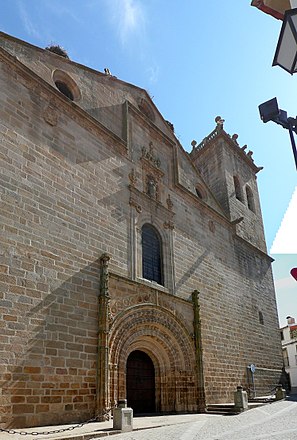Brozas
| Brozas municipality | ||
|---|---|---|
 Brozas - Iglesia de Santa María la Mayor de la Asunción
|
||
| coat of arms | Map of Spain | |

|
|
|
| Basic data | ||
| Autonomous Community : |
|
|
| Province : | Cáceres | |
| Comarca : | Tagus Salor | |
| Coordinates | 39 ° 37 ′ N , 6 ° 47 ′ W | |
| Height : | 410 msnm | |
| Area : | 398.84 km² | |
| Residents : | 1,826 (Jan 1, 2019) | |
| Population density : | 4.58 inhabitants / km² | |
| Postal code : | 10950 | |
| Municipality number ( INE ): | 10032 | |
| administration | ||
| Website : | Brozas | |
Brozas is a place and a municipality ( municipio ) with 1,826 inhabitants (as of January 1, 2019) in the province of Cáceres in the autonomous region of Extremadura in southwestern Spain . The old town center is classified as a cultural asset ( Bien de Interés Cultural ) in the Conjunto histórico-artístico category.
location
The place Brozas is about 50 km (driving distance) northwest of the provincial capital Cáceres at an altitude of about 410 m . The town of Alcántara , known beyond the borders of Spain and not far from the border with Portugal , is only 16 km to the north-west. The climate is temperate to warm; Rain (approx. 635 mm / year) falls mainly in the winter half-year.
Population development
| year | 1842 | 1900 | 1950 | 2000 | 2017 |
| Residents | 5,525 | 5,143 | 5,960 | 2,328 | 1.911 |
The significant population decline since the 1950s is mainly due to the mechanization of agriculture and the abandonment of small farms and the associated loss of jobs.
economy
The fertile but stony soils in the area provided the basis for the cultivation of wheat and other crops for the inhabitants who, in earlier times, were mainly self-sufficient . In the growing small town itself, traders, craftsmen and service providers of all kinds gradually settled.
history
Small bronze , Iron Age and Roman finds were made in small numbers; the area belonged to the Roman province of Lusitania for a long time . The Visigoths left hardly any traces. The region was overrun by the Arabs and their Moorish auxiliaries in the 8th century ; However, there is no archaeological evidence. Brozas (formerly Las Broças ) and the surrounding area were occupied by the Castilian - Leonese troops of Alfonso IX around 1213 . (r. 1188–1230) recaptured from the hands of the Moors ( reconquista ) , then handed over to the Alcántara order and successively repopulated by Christians from the north and refugees from Al-Andalus ( repoblación ) . In the 15th century there were repeated clashes in the area between the rival kingdoms of Castile and Portugal for territorial claims , which were only ended towards the end of the century by the Catholic kings Isabella of Castile and Ferdinand of Aragón . Under Charles I (r. 1516–1556) Brozas was granted city rights in 1537 in return for a payment of 7,500 gold ducats , thus breaking away from its dependence on the Alcántara Order. This was followed by an enormous economic and demographic upswing, which was interrupted by the plague epidemic from 1599 to 1601.
Attractions
- Brozas impresses with numerous churches (iglesias) , hermitages (ermitas) , convents (conventos) and aristocratic palaces (palacios) with stone heraldic shields .
- The most important religious building in town is the resultant in place of a simple previous building in the 16th century Iglesia de Santa María la Mayor y de la Asunción (also La Catedralina called = "small cathedral"), which at first glance Romanesque -sounding West Portal both style influences Late Gothic and Renaissance shows; Particularly noteworthy are the archivolts arches with figures of angels holding the instruments of Christ's passion in their hands. The west facade, on the other hand, is kept extremely plain. Another portal (Portal de la Umbria) shows exclusively Renaissance forms and ornaments. The three-aisled, but equally high church interior ( hall church ) is spanned by a late Gothic star vault. The late baroque main altar (retablo mayor) dates from the middle of the 18th century .
- The Palacio de los Condes de Canilleros with an unusual coat of arms placed across the corner dates from the same period .
- Surroundings
- About one kilometer outside of the village is the Convento de las Comendadoras de Alcántara , also built in the 16th century , which was converted into a hotel towards the end of the 20th century.
Web links
- Brozas, sights - photos (spanish)
Individual evidence
- ↑ Cifras oficiales de población resultantes de la revisión del Padrón municipal a 1 de enero . Population statistics from the Instituto Nacional de Estadística (population update).
- ↑ Brozas - climate tables
- ^ Brozas - population development
- ^ Brozas story
- ↑ Brozas - Church of Santa María la Mayor y de la Asunción
- ↑ Brozas - Church of Santa María la Mayor y de la Asunción
- ↑ Brozas - Church of Santa María la Mayor y de la Asunción


